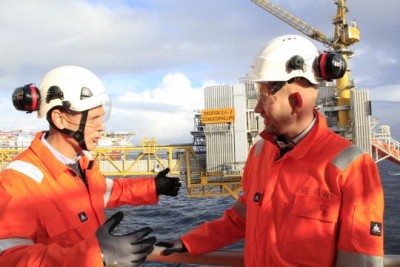Norway’s oldest oil field, Ekofisk, got a new lease on life this week, just as news broke that a conflict over the Snorre field was finally settled, clearing the way for it to also be developed at a cost of around NOK 40 billion. The future of Norway’s oil industry nonetheless remains a subject of great debate, with economists, politicians and even some industrialists warning that the country has become far too dependent on a resource that’s also an environmental liability.

As Norway’s new Oil & Energy Minister Tord Lien made his first official trip out to an oil rig at Ekofisk in the North Sea, predictions were still streaming in that the oil era is nearing an end and that the new government needs to stake out a new course for the Norwegian economy. Handelsbanken, for example, issued a new report just last week entitled “How long can oil pull the full load?” in which bank economists worry about the economic future of the country still believed to be among the wealthiest in the world.
For one thing, as economists have warned for years, the oil fields will eventually run dry even though state oil company Statoil and other major players have made some huge new oil discoveries in recent years. Environmental and climate concerns make exploration and development of new fields in the Arctic risky and unpopular. And the current high price of oil can fall at any time, with state statistics bureau SSB predicting a drop to around USD 70 a barrel by 2025, down from today’s prices of more than USD 100. That will lead to layoffs and higher unemployment in Norway, predicts DNB Markets.
Norway’s new government, notes Handelsbanken economist Knut Anton Mork, has promised more investment in schools, transport, health care and elder care, along with various tax cuts. Oil revenues are expected to finance much of this, and “it can be challenging,” Mork told newspaper Dagens Næringsliv (DN).

As more environmentally conscious consumers turn to alternative energy sources and products, not least electric cars, demand and prices for oil are expected to drop, and state revenues accordingly. State coffers also stand to lose the tax revenues tied to the oil industry, forcing much tighter budgets for both the state and Norwegian households. Mork believes, though, that the time is ripe for more public investment in infrastructure and expertise, “because we must prepare for an age after oil, and then we’ll need both the investment and the competence.”
Rasmus Hansson, the newly elected Member of Parliament from the Greens Party, which won representation for the first time, says Prime Minister Erna Solberg’s new conservative government must listen to all the warnings and reduce Norway’s dependence on oil. He wants her to listen also to investor and industrialist Jens Ulltveit-Moe, who rather surprisingly called during the election campaign for a halt to development of all new oil fields on the Norwegian Continental Shelf.
Ulltveit-Moe believes that Norway “should milk its existing oil fields for all the oil we’ve already found, and stop development of new fields,” because new fields in remote and deep waters pose huge economic and environmental risks. Ulltveit-Moe also proposes higher carbon taxes in exchange for lower income taxes, and far more investment in wind- and water-propelled energy projects.
Need for sustainability
Such radical proposals from a businessman like Ulltveit-Moe were both rejected and praised, with Hansson among his supporters. He agrees that Norway needs to invest in and develop more sustainable businesses that also will diversify Norway’s economy. Hansson ultimately wants to phase out the oil industry all together and replace it with wind energy projects, while also lowering Norwegian pay levels and imposing taxes that will promote “greener” lifestyles.
Former Oil & Energy Minister Ola Borten Moe of the Center Party, known for being bullish on Norway’s oil industry and firmly in favour of expanding it, was quick to bash both Hansson and Ulltveit-Moe. His successor, Tord Lien of the conservative Progress Party, who visited Ekofisk on Tuesday, seems more moderate than Moe, but made it clear that oil and gas will remain a critical part of the Norwegian economy for many years to come, and the pumping will continue.
Ekofisk alone, Lien noted, has potential for operations until 2050. The field that lies around 300 kilometers southwest of Stavanger, was the first to start producing oil for Norway when it opened in 1971. Today it’s still producing oil and gas equivalent to 200,000 barrels a day and Lien formally opened a new platform at Ekofisk.
‘Historic’ day
“I’m especially honoured to be here on this important day for Ekofisk, a day that’s historic for all of Norway,” Lien claimed in his remarks on the platform. “We are opening a platform that can extract oil from Ekofisk for 40 more years.” Around NOK 85 billion will be invested in the field that’s operated by Conoco Philips, with rights also held by Total, ENI, Statoil and Petoro.
Farther north at the Snorre field, located in one of the most important production areas on the Norwegian Continental Shelf, Statoil and Petoro, which holds the state’s direct investment in oil, finally settled a conflict over development with yet another new platform. The potential for more oil from Snorre made profit prospects strong enough also for Statoil to justify another NOK 40 billion investment in the field, which has produced since 1992.
As offshore activity hums along, though, calls for economic diversification are bound to continue. There will be no “revolution” in oil production, new government leaders have said, and Lien has a background in renewable energy that has encouraged environmentalists. The politicians now in power claim they will bear Norway’s share of responsibility for reversing climate change, but also intend to pump up the oil that’s out there. The tempo in the Barents, though, has already shown signs of tapering off following new limits put on exploration in areas where Moe was eager to drill.
newsinenglish.no/Nina Berglund

